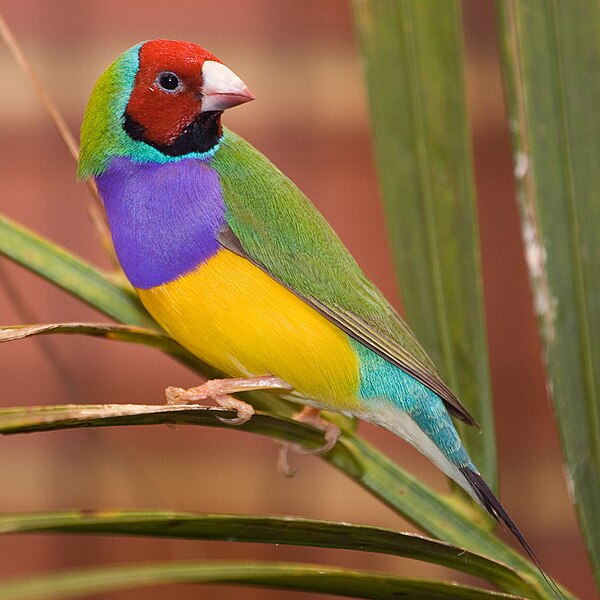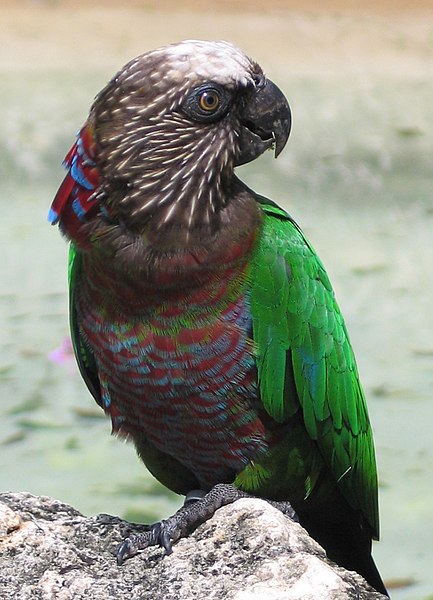 Amethyst Starlings in Captivity
Amethyst Starlings in Captivity
Please see Part I of this article for information about the natural history of the amethyst starling. More popular with European than American aviculturists, amethyst starlings (Cinnyricinlus leucogaster) are none-the-less regularly bred in this country. In my opinion, those looking to expand their collection can ask for no more interesting an avian project than keeping a pair of amethyst starlings. They will require a huge enclosure – one of our larger outdoor aviaries would be ideal – and indoor winter quarters in most of the USA, but are well-worth the effort.
Reproduction and Hand-Rearing
Incubation lasts for approximately 14 days. The chicks fledge at day 18-22, after which they are fed by the parents for an additional 10 days or so. Adult starlings have been seen to cover their eggs with leaves when departing from the nest.
The chicks, being ravenous feeders and taking a wide variety of foods, are not difficult to hand rear. I have hand-raised chicks of the closely related European starling (see photos) for use in educational programs; without fail they became amazingly tame and confiding – curious about everything and a source of great pleasure for thousands of school children.
Diet
The appetite of the amethyst starling, like that of nearly all its relatives, is expansive and easy to satisfy. They feed with gusto, and do best on a varied diet. Diets I use in zoos and at home are based around such foods as myna and softbill pellets, fruit pudding, mixed fruits and vegetables and nearly any live or canned insect available. An occasional dead pink mouse or hard boiled egg will be devoured with very evident pleasure.
Further Reading
You can read about the Jacksonville Zoo’s amethyst starlings at
http://www.jaxzoo.org/things/biofacts/AmethystStarling.asp.
Amethyst Starling image referenced from Wikipedia and originally posted by LTShears
 That Bird Blog – Bird Care and History for Pet Birds
That Bird Blog – Bird Care and History for Pet Birds

 In addition to thrilling bird owners for the past 100 years or so, it seems that the males’ spectacular plumage plays an unexpected role in Gouldian finch behavior as well. Wild Gouldian finches are unique in possessing heads that may be red, black or yellow in color. Red-headed males dominate all others, with yellow headed males being at the bottom of the pecking order.
In addition to thrilling bird owners for the past 100 years or so, it seems that the males’ spectacular plumage plays an unexpected role in Gouldian finch behavior as well. Wild Gouldian finches are unique in possessing heads that may be red, black or yellow in color. Red-headed males dominate all others, with yellow headed males being at the bottom of the pecking order. Also known as the Barbary, ring-necked or domestic dove, ring doves (Streptopelia risoria) are among the most popular and confiding of all pigeon-like birds. Although given species status, this quiet, 9 inch-long bird may be a mere variant of the African collared dove (S. roseogrisea), which was domesticated nearly 3,000 years ago. Those in the pet trade likely also carry the genes of the Eurasian collared dove (S. decaocto) and the red-eyed dove (S. semitorquata), rendering them truly unique.
Also known as the Barbary, ring-necked or domestic dove, ring doves (Streptopelia risoria) are among the most popular and confiding of all pigeon-like birds. Although given species status, this quiet, 9 inch-long bird may be a mere variant of the African collared dove (S. roseogrisea), which was domesticated nearly 3,000 years ago. Those in the pet trade likely also carry the genes of the Eurasian collared dove (S. decaocto) and the red-eyed dove (S. semitorquata), rendering them truly unique. The vibrant colors and unique erectile head crest of the hawk headed or red fan parrot (Deroptyus accipitrinus) have long rendered it a favorite pet in its native South America. After the first exports in the mid 1800’s, the bird achieved instant stardom in zoos and private collections worldwide.
The vibrant colors and unique erectile head crest of the hawk headed or red fan parrot (Deroptyus accipitrinus) have long rendered it a favorite pet in its native South America. After the first exports in the mid 1800’s, the bird achieved instant stardom in zoos and private collections worldwide.